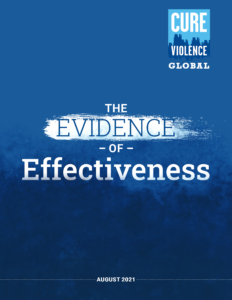As conflict surges worldwide, many are searching for innovative strategies to reduce violence. Thankfully, alternative methods have long existed, from indigenous peacemaking to Black feminist restorative justice praxis to Cure Violence Global’s public health approach: stopping violent conflict by treating it as a disease.
 As a data-driven, evidence-based program, CVG has always prioritized evaluation as a critical component of its work. As a result, there have been eight independent evaluations and a dozen studies measuring the efficacy of the approach and model. Cure Violence Global recently released a comprehensive summary of these independent evaluations and studies spanning multiple years and sites. Please click here to view the report in its entirety.
As a data-driven, evidence-based program, CVG has always prioritized evaluation as a critical component of its work. As a result, there have been eight independent evaluations and a dozen studies measuring the efficacy of the approach and model. Cure Violence Global recently released a comprehensive summary of these independent evaluations and studies spanning multiple years and sites. Please click here to view the report in its entirety.
According to the research, some of the hardest hit communities in the United States, Latin America, and the Caribbean have reduced shootings and killings by 40-70%. In some instances, shootings and killings have plummeted by 90% and Cure Violence Global’s efforts have almost eliminated retaliatory violence in some communities. Several previously highly violent neighborhoods have had months-long streaks with no homicides or shootings.
In 2017, an evaluation by the John Jay College of Criminal Justice recorded a 63% decrease in shootings within New York’s South Bronx district. In 2020, ICESI University, in Cali, Colombia, found that killings in Cali’s Charco Azul community declined by 47%. In over a dozen other cities, studies have shown a downward trend in violent behavior, primarily associated with Cure Violence tactics.
Beyond the direct impacts of violence reduction, evidence demonstrates that many communities also experienced social and economic growth. The second pillar in the CVG model is changing the behaviors of the highest risk individuals, in part by connecting them with appropriate community services including education and employment opportunities, health care, and other resources that can transform their lives. Several studies also indicate positive shifts in feelings of safety and community norms about violence, including, in some cases, increased confidence in the police.
The Evidence of Effectiveness report highlights the prominent endorsements of local and national politicians, academics and evaluators, and community leaders. Their testimonies complement the scientific data, and champion the health approach as a transformative means to improving public safety.
Public health measures to prevent violence offer a significant return on investment. In the process of investing in community safety, Cure Violence Global saves $33 for every dollar spent. Additionally, the analysis conveys that millions of dollars are saved each year for every killing prevented.
The data paints a clear picture: Cure Violence works. It’s important to recognize that behind the formidable success of the program are the Violence Interrupters and Outreach Workers who risk their lives to improve the lives of others. Across various regions and years, they continue to demonstrate the efficacy of community-led, health-based public safety.
The more we all know about successful, data-driven solutions to complex problems, the better our ability to advocate for effective public policy that prioritizes the health outcomes of vulnerable communities. Please join us in calling on community leaders and public officials to embrace and support implementation of health-based violence prevention programs.


